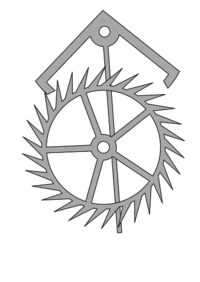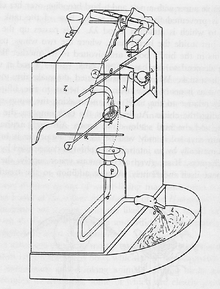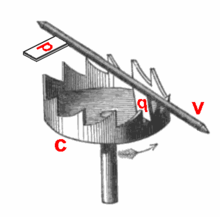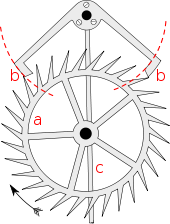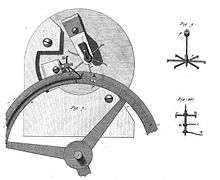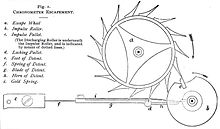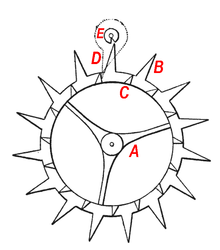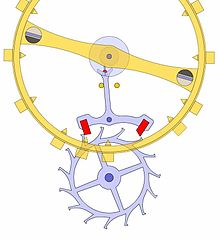- Escapement
-
"Escapement" redirects here. For the fisheries term for the stock surviving fishing pressures over a spawning cycle, see Spawn (biology).For other uses, see Escapement (disambiguation).
In mechanical watches and clocks, an escapement is a device that (1) transfers energy to the timekeeping element and (2) enables counting the number of oscillations of the timekeeping element. It is the source of the "ticking" sound in watches and clocks.
An escapement transfers energy to the clock's timekeeping element (usually a pendulum or balance wheel) to make up the energy lost during a cycle. Without the energy transfer, the oscillation would cease. The escapement may take the energy from a coiled spring (e.g., in a wristwatch) or a suspended weight (e.g., in a cuckoo or grandfather clock). The escapement also permits each cycle of the timekeeping element to be counted. During each cycle, the escapement permits a gear train to advance or "escape" slightly. The periodic advancement results in moving the timepiece's hands forward at a steady rate.
With each swing of the pendulum, one of its arms releases one tooth of a gear, making it change from a "locked" state to a "drive" state for a short period that ends when another tooth on the gear strikes the opposite arm of the pendulum, which locks the gear again. It is this periodic release of energy and rapid stopping that makes a clock "tick;" it is the sound of the gear train suddenly stopping when the escapement locks again.
Contents
History
The importance of the escapement in the history of technology is that it was the key invention that made the all-mechanical clock possible.[1][2] This development in 13th century Europe initiated a change in timekeeping methods from continuous processes, such as the flow of water in water clocks, to repetitive oscillatory processes, such as the swing of pendulums, which could yield more accuracy.[2] Oscillating timekeepers are used in every modern clock.
Liquid-driven escapement
The earliest liquid-driven escapement was described by the Greek engineer Philo of Byzantium (3rd century BC) in his technical treatise Pneumatics (chapter 31) as part of a washstand.[3] A counterweighted spoon, supplied by a water tank, tips over in a basin when full, releasing a spherical piece of pumice in the process. Once the spoon has emptied, it is pulled up again by the counterweight, closing the door on the pumice by the tightening string. Remarkably, Philo's comment that "its construction is similar to that of clocks" indicates that such escapement mechanisms were already integrated in ancient water clocks.[3]
In China, the Tang Dynasty Buddhist monk Yi Xing along with government official Liang Lingzan applied the escapement in 723 (or 725) to the workings of a water-powered armillary sphere and clock drive.[4] The Song Dynasty (960–1279) era horologists Zhang Sixun (fl. late 10th century) and Su Song (1020–1101) duly applied escapement devices for their astronomical clock towers,[5] before the technology stagnated and retrogressed.[6] According to Ahmad Y Hassan, a mercury escapement in a Spanish work for Alfonso X in 1277 can be traced back to earlier Arabic sources.[7][unreliable source?] Knowledge of these mercury escapements may have spread through Europe with translations of Arabic and Spanish texts.[7][8]
However, none of these were true mechanical escapements, since they still depended on the flow of liquid through an orifice to measure time.[6] For example, in Su Song's clock, water flowed into a container on a pivot. The escapement's role was to tip the container over each time it filled up, thus advancing the clock's wheels each time an equal quantity of water was measured out. The development of mechanical clocks, though, depended on the invention of an escapement which would allow a clock's movement to be controlled by an oscillating weight. Unlike the continuous flow of water in the Chinese device, the medieval escapement was characterized by a regular, repeating sequence of discrete actions and the capability of self-reversing action:
Both techniques used escapements, but these have only the name in common. The Chinese one worked intermittently; the European, in discrete but continuous beats. Both systems used gravity as the prime mover, but the action was very different. In the mechanical clock, the falling weight exerted a continuous and even force on the train, which the escapement alternately held back and released at a rhythm constrained by the controller. Ingeniously, the very force that turned the scape wheel then slowed it and pushed it part of the way back . . . In other words, a unidirectional force produced a self-reversing action—about one step back for three steps forward. In the Chinese timekeeper, however, the force exerted varied, the weight in each successive bucket building until sufficient to tip the release and lift the stop that held the wheel in place. This allowed the wheel to turn some ten degrees and bring the next bucket under the stream of water while the stop fell back . . . In the Chinese clock, then unidirectional force produced unidirectional motion.[9]
Mechanical escapement
Villard de Honnecourt invented a primitive form of escapement, in an apparatus that was apparently a timekeeping device, but without being subject to any minute requirement of accuracy.[10] The first mechanical escapement, the verge escapement, was used in a bell ringing apparatus called an alarum for several centuries before it was adapted to clocks.[11] In 14th century Europe it appeared as the timekeeper in the first mechanical clocks, which were large tower clocks. Its origin and first use is unknown because it is difficult to distinguish which of these early tower clocks were mechanical, and which were water clocks.[12] However, indirect evidence, such as a sudden increase in cost and construction of clocks, points to the late 13th century as the most likely date for the development of the modern clock escapement. Astronomer Robertus Anglicus wrote in 1271 that clockmakers were trying to invent an escapement, but hadn't been successful yet.[13] On the other hand, most sources agree that mechanical escapement clocks existed by 1300.>[14]
Actually, the earliest description of an escapement, in Richard of Wallingford's 1327 manuscript Tractatus Horologii Astronomici on the clock he built at the Abbey of St. Albans, was not a verge, but a variation called a 'strob' escapement.[15][16] It consisted of a pair of escape wheels on the same axle, with alternating radial teeth. The verge rod was suspended between them, with a short crosspiece that rotated first in one direction and then the other as the staggered teeth pushed past. Although no other example is known, it is possible that this was the first clock escapement design.[15]
However the verge was the standard escapement used in every other early clock and watch, and remained the only escapement for 400 years. Its friction and recoil limited its performance, but the accuracy of these 'verge and foliot' clocks was more limited by their early foliot type balance wheels, which because they lacked a balance spring had no natural 'beat', so there was not much incentive to improve the escapement.
The great leap in accuracy resulting from the invention of the pendulum and balance spring around 1657, which made the timekeeping elements in both watches and clocks harmonic oscillators, focused attention on the errors of the escapement, and more accurate escapements soon superseded the verge. The next two centuries, the 'golden age' of mechanical horology, saw the invention of perhaps 300 escapement designs, although only about 10 stood the test of time and were widely used.[17] These are described individually below.
The invention of the crystal oscillator and the quartz clock in the 1920s shifted technological research in timekeeping to electronic methods, and largely put an end to escapement design.
Reliability
The reliability of an escapement depends on the quality of workmanship and the level of maintenance given. A poorly constructed or poorly maintained escapement will cause problems. The escapement must accurately convert the oscillations of the pendulum or balance wheel into rotation of the clock or watch gear train, and it must deliver enough energy to the pendulum or balance wheel to maintain its oscillation.
In many escapements, the unlocking of the escapement involves sliding motion; for example, in the animation shown above, the pallets of the anchor slide against the escapement wheel teeth as the pendulum swings. The pallets are often made of very hard materials such as polished stone (for example, artificial ruby), but even so they normally require lubrication. Since lubricating oil degrades over time due to evaporation, dust, oxidation, etc., periodic re-lubrication is needed. If this is not done, the timepiece may work unreliably or stop altogether, and the escapement components may be subjected to rapid wear. The increased reliability of modern watches is due primarily to the higher-quality oils used for lubrication. Lubricant lifetimes can be greater than five years in a high-quality watch.
Some escapements avoid sliding friction; examples include the grasshopper escapement of John Harrison in the 18th century, and the co-axial escapement of George Daniels in the 20th century. This may avoid the need for lubrication in the escapement (though it does not obviate the requirement for lubrication of other parts of the gear train).
Accuracy
The accuracy of a mechanical clock is dependent on the accuracy of the timing device. If this is a pendulum, then the period of swing of the pendulum determines the accuracy. If the pendulum rod is made of metal it will expand and contract with heat, shortening or lengthening the pendulum; this changes the time taken for a swing. Special alloys are used in expensive pendulum-based clocks to minimize this distortion. Pendulum swings also vary according to how big the arc is; highly-accurate pendulum-based clocks have very small arcs. Pendulum-based clocks can achieve outstanding accuracy. Even into the 20th century, pendulum-based clocks were reference time pieces in laboratories, although at sea the natural motion of the vessel severely impairs the accuracy of a pendulum. Escapements play a big part in accuracy as well. The precise point in the pendulum's travel at which impulse is supplied will determine how closely to time the pendulum will swing. Ideally, the impulse should be evenly distributed on either side of the lowest point of the pendulum's swing. This is because pushing a pendulum when it's moving towards mid-swing makes it gain, whereas pushing it while it's moving away from mid-swing makes it lose. If the impulse is evenly distributed then it gives energy to the pendulum without changing the time of its swing.[18]
The crucial element in escapement design is to give just enough energy to the pendulum in order to keep it swinging, and to interfere with the free swinging of the pendulum as little as is possible. As the lubrication of the escapement ages, friction will increase, and less power will be transferred to the timing device (for example, the pendulum). If the timing device is a pendulum, this means the pendulum will swing a shorter and shorter arc. Contrary to popular opinion, the time taken for a pendulum swing is not constant regardless of the size of the swing; the swing time changes with the size of the swing. Therefore, a dirty escapement will cause inaccuracy because the arc of the pendulum swing becomes shorter (the clock will speed up). To minimize this effect, pendulum swings are kept as small as possible.
Wristwatches, and smaller clocks, do not use pendulums as the timing device. Instead, they use balance springs; fine springs connected to a metal balance wheel (imagine a bicycle wheel without the tire). The balance wheel rotates back and forth; a good Swiss watch has a frequency of 4Hz (4 cycles—or 8 beats—per second). Faster speeds are used in some watches. The balance spring must also be temperature neutral. Very sophisticated alloys are used; in this area, watchmaking is still advancing. As with the pendulum, the escapement must provide a small kick each cycle to keep the balance wheel oscillating. Also, the same lubrication problem occurs over time; the watch will lose accuracy (typically it will speed up) when the escapement lubrication starts failing.
Pocket watches were the predecessor of modern wristwatches. Pocket watches, being in the pocket, were usually in a vertical orientation. Gravity causes some loss of accuracy as it magnifies over time any lack of symmetry in the balance mechanism. The 'tourbillon' was invented to minimize this: the balance spring is put in a cage which rotates (typically once a minute), smoothing gravitational distortions. This very clever and sophisticated clock-work is a prized 'complication' in wrist-watches, even though the natural movement of the wearer tends to smooth gravitational influences much more than for a pocketwatch.
The most accurate commercially produced mechanical clock was the Shortt-Synchronome free pendulum clock invented by W. H. Shortt in 1921, which had an error rate of about 1 second per year.[19] [20] The most accurate mechanical clock to date is probably the Littlemore Clock, built by noted archaeologist E. T. Hall in the 1990s. In Hall's paper,[21] he reports an error of 3 parts in 109 measured over 100 days (an error of about 0.02 seconds over that period). Both of these clocks are electromechanical clocks: they use a pendulum as the timekeeping element, but electrical power rather than a mechanical gear train to supply energy to the pendulum.
Mechanical escapements
Since 1658 when the introduction of the pendulum and balance spring made accurate timepieces possible, it has been estimated that more than three hundred different mechanical escapements have been devised, but only about 10 have seen widespread use.[22] These are described below. In the 20th century, electric timekeeping methods replaced mechanical clocks and watches, so escapement design became a little known curiosity.
Verge escapement
The earliest escapement in Europe (from about 1275)[citation needed] was the verge escapement, also known as the crown-wheel escapement. It was used in the first mechanical clocks and was originally controlled by a foliot, a horizontal bar with weights at either end. The escapement consists of an escape wheel shaped somewhat like a crown, with pointed teeth sticking axially out of the side, oriented vertically. In front of the crown wheel is a vertical shaft, the verge, attached to the foliot at top, which carries two metal plates (pallets) sticking out like flags from a flag pole, oriented about ninety degrees apart, so only one engages the crown wheel teeth at a time. As the wheel turns, one tooth pushes against the upper pallet, rotating the verge and the attached foliot. As the tooth pushes past the upper pallet, the lower pallet swings into the path of the teeth on the other side of the wheel. A tooth catches on the lower pallet, rotating the verge back the other way, and the cycle repeats. A disadvantage of the escapement was that each time a tooth lands on a pallet, the momentum of the foliot pushes the crown wheel backwards a short distance before the force of the wheel reverses the motion. This is called "recoil" and was a source of wear and inaccuracy.
The verge was the only escapement used in clocks and watches for 400 years. In watches it required a fusee to even out the force of the mainspring. It was used in the first pendulum clocks for about 50 years after the pendulum clock was invented in 1656. In a pendulum clock the crown wheel and verge were oriented so they were horizontal, and the pendulum was hung from the verge. However the verge is the most inaccurate of the common escapements, and after modern timekeeping oscillators (the pendulum and the sprung balance wheel) were introduced in the 1650s the verge was replaced by other escapements by about 1800.
Cross-beat escapement
Jost Bürgi invented the cross-beat escapement in 1584, a two foliots refinement of the verge escapement. Along with his invention of the remontoire this improved the accuracy of mechanical clock of his time by two orders of magnitude and allowed his clocks to be correct to within a minute a day.[23]
Anchor escapement
Invented around 1660 by Robert Hooke, the anchor quickly superseded the verge to become the standard escapement used in pendulum clocks through the 19th century. Its advantage was that it reduced the wide pendulum swing angles of the verge to 3°-6°, making the pendulum isochronous, and allowing the use of longer, slower moving pendulums, which used less energy. It is responsible for the long narrow shape of most pendulum clocks, particularly grandfather clocks.
It consists of an escape wheel with pointed, backward slanted teeth, and an 'anchor' shaped piece pivoted above it which rocks from side to side, attached to the pendulum. The anchor has slanted pallets on the arms which alternately catch on the teeth of the escape wheel, receiving impulses. Mechanically its operation has similarities to the verge escapement, and it has two of the verge's disadvantages: (1) The pendulum is constantly being pushed by an escape wheel tooth throughout its cycle, and is never allowed to swing freely, which disturbs its isochronism, and (2) it is a recoil escapement; the anchor pushes the escape wheel backward during part of its cycle. This causes backlash, increased wear in the clocks gears, and inaccuracy. These problems were eliminated in the deadbeat escapement, which slowly replaced the anchor in precision clocks.
Deadbeat escapement
The deadbeat escapement was an improvement of the anchor escapement first made by Thomas Tompion to a design by Richard Towneley in 1675[25][26][27] although it is often credited to Tompion's successor George Graham who popularized it in 1715.[28] In the anchor escapement the swing of the pendulum pushes the escape wheel backward during part of its cycle. This 'recoil' disturbs the motion of the pendulum, causing inaccuracy, and reverses the direction of the gear train, causing backlash and introducing high loads into the system, leading to friction and wear. The main advantage of the deadbeat is that it eliminated recoil.[11]
In the deadbeat, the pallets have a second curved "locking" face on them, concentric about the pivot on which the anchor turns. During the extremities of the pendulum's swing, the escape wheel tooth rests against this locking face, providing no impulse to the pendulum, which prevents recoil. Near the bottom of the pendulum's swing the tooth slides off the locking face onto the angled "impulse" face, giving the pendulum a push, before the pallet releases the tooth. This was the first escapement to separate the locking and impulse actions of the escapement.[citation needed] The deadbeat was first used in precision regulator clocks, but due to greater accuracy superseded the anchor in the 19th century. It is used in almost all modern pendulum clocks.[18] The deadbeat escapement does rely on a quality wheel train to receive constant impulse. Variations in the impulse will affect the pendulum arc and the accuracy of the clock. For this reason it is not always the best choice for cheap mass produced clocks, or for tower clocks with large hands exposed to the outside weather.
Detent escapement
The detent or chronometer escapement is a type of detached escapement,[29] and was most commonly used on marine chronometers, although some precision watches during the 19th century also used it.[30] The early form was invented by Pierre Le Roy in 1748, who created a pivoted dentent type of escapement.[29][31][32] The invention was then generalized in 1783 by Thomas Earnshaw with his standard spring-detent escapement (John Arnold created a variant, patented in 1779, as did Ferdinand Berthoud, but the Earnshaw design was the one generally adopted)[31][33] and used until mechanical chronometers became obsolete in the 1970s. They could be made far more accurate than lever escapements,[34] due to the virtual absence of sliding friction between the escape tooth and the pallet during impulse. Yet they were extremely fragile, not self-starting, and harder to manufacture in volume. Unlike the lever escapement, the impulse to the balance occurs at every other swing. Usually a balance making 4 swings per second with a helical balance spring was used.
Cylinder escapement
The cylinder escapement was an improvement over the verge escapement in terms of time keeping abilities, but it was not easy to manufacture, was somewhat fragile and the escape wheel was in constant contact with the balance which caused it to need regular cleaning due to wear. It was commonly used by the French watchmakers, although the Swiss also used it quite a bit.
Duplex escapement
The duplex watch escapement was invented by Robert Hooke around 1700, improved by Jean Baptiste Dutertre and Pierre Le Roy, and put in final form by Thomas Tryer, who patented it in 1782.[35] It was used in quality English pocketwatches from about 1790 to 1860,[36][37][38] and in the Waterbury, a cheap American 'everyman's' watch, during 1880-1898.[39] [40] In the duplex, as in the chronometer escapement to which it has similarities, the balance wheel only receives an impulse during one of the two swings in its cycle.[36] The escape wheel has two sets of teeth (hence the name 'duplex'); long locking teeth project from the side of the wheel, and short impulse teeth stick up axially from the top. The cycle starts with a locking tooth resting against the ruby disk. As the balance wheel swings counterclockwise through its center position, the notch in the ruby disk releases the tooth. As the escape wheel turns, the pallet is in just the right position to receive a push from an impulse tooth. Then the next locking tooth drops onto the ruby roller and stays there while the balance wheel completes its cycle and swings back clockwise (CW), and the process repeats. During the CW swing, the impulse tooth falls momentarily into the ruby roller notch again, but isn't released.
The duplex is a frictional rest escapement; the balance is never totally free from the escapement because of the tooth resting against the roller.[36][41] As in the chronometer, there is little sliding friction during impulse since pallet and impulse tooth are moving almost parallel, so little lubrication is needed. The duplex is capable of accuracy at least equal to the lever escapement, and perhaps approaching the chronometer.[42] However it lost favor to the lever; its tight tolerances and sensitivity to shock made duplex watches unsuitable for active people. Like the chronometer, it is not self-starting and is vulnerable to "setting;" if a sudden jar stops the balance during its CW swing, it can't get started again.
Lever escapement
The lever escapement, invented by Thomas Mudge in 1750, has been used in the vast majority of watches since the 19th century. Its advantages are (1)the balance wheel is more "detached" or independent than in the cylinder or duplex escapements; it is only in contact with the lever during the short impulse period when the balance swings through its center position, increasing accuracy, and (2) it is a self-starting escapement, so if the watch is shaken so that the balance wheel stops, it will automatically start again. The original form was the rack lever escapement, in which the lever and the balance wheel were always in contact via a gear rack on the lever. Later, it was realized that all the teeth from the gears could be removed except one, and this created the detached lever escapement. British watchmakers used the English detached lever, in which the lever was at right angles to the balance wheel. Later Swiss and American manufacturers used the inline lever, in which the lever is inline between the balance wheel and the escape wheel; this is the form used in modern watches. In 1867 Georges Frederic Roskopf invented an inexpensive, less accurate form called the Roskopf or pin-pallet escapement, which was used in cheap "dollar watches" in the early 20th century and is still used in cheap alarm clocks and kitchen timers.
Grasshopper escapement
A rare but interesting mechanical escapement is John Harrison's grasshopper escapement. In this escapement, the pendulum is driven by two hinged arms (pallets). As the pendulum swings, the end of one arm catches on the escape wheel and drives it slightly backwards; this releases the other arm which moves out of the way to allow the escape wheel to pass. When the pendulum swings back again, the other arm catches the wheel, pushes it back and releases the first arm and so on. The grasshopper escapement is more difficult to manufacture than other escapements and is something of a rarity. Grasshopper escapements made by Harrison in the 18th century are still operating. Most escapements wear far more quickly, and waste far more energy.
Gravity escapement
 Double three-legged gravity escapement
Double three-legged gravity escapement
A gravity escapement uses a small weight or a weak spring to give an impulse directly to the pendulum. The earliest form consisted of two arms which were pivoted very close to the suspension spring of the pendulum with one arm on each side of the pendulum. Each arm carried a small dead beat pallet with an angled plane leading to it. When the pendulum lifted one arm far enough its pallet would release the escape wheel. Almost immediately another tooth on the escape wheel would start to slide up the angle face on the other arm thereby lifting the arm. It would reach the pallet and stop. The other arm meanwhile was still in contact with pendulum and coming down again to a point lower than it had started from. This lowering of the arm provides the impulse to the pendulum. The design was developed steadily from the middle of the 18th century to the middle of the 19th century. It eventually became the escapement of choice for turret clocks and has recently been perfected in the inertially-detached gravity escapement invented by James Arnfield. This frees the pendulum from any part in unlocking the clock train; all it does is lift a gravity arm and then later on part company from it at a lower point. They part company because the gravity arm comes into contact with, and unlocks, the mechanism which re-sets the gravity arm in its raised position.
In the animation shown here the two "gravity arms" are coloured blue and red. The two three-legged escape wheels are also coloured blue and red. They work in two parallel planes so that the blue wheel only impacts the locking block on the blue arm and the red wheel only impacts the red arm. In a real escapement these impacts give rise to loud audible "ticks" and these are indicated by the appearance of a * beside the locking blocks. The three black lifting pins are key to the operation of the escapement. They cause the weighted gravity arms to be raised by an amount indicated by the pair of parallel lines on each side of the escapement. This gain in potential energy is the energy given to the pendulum on each cycle. For the Trinity College Cambridge Clock a mass of around 50 grams is lifted through 3mm each 1.5 seconds - which works out to 1 mW of power. The driving power from the falling weight is about 12 mW, so there is a substantial excess of power used to drive the escapement. Much of this energy is dissipated in the acceleration and deceleration of the frictional "fly" attached to the escape wheels.
Co-axial escapement
Invented around 1974[43] and patented 1980[44] by British watchmaker George Daniels, the co-axial escapement is one of the few new watch escapements adopted commercially in modern times. It is a modification of the lever that has some features of the detent escapement. Its main advantage is that through a complicated system of 3 pallets that separates the locking function from the impulse, it is able to avoid the sliding friction of the lever escapement, making lubrication of the pallets unnecessary.[45][46] Purchasers no longer buy mechanical watches primarily for their accuracy, so manufacturers had little interest in investing in the tooling required, although finally Omega adopted it in 1990.[46] While low-friction escapements existed already, they were too large for small "movements" (as watch-work is referred to).[citation needed]
Electromechanical escapements
In the late 19th century, electromechanical escapements were developed for pendulum clocks. In these, a switch or phototube energised an electromagnet for a brief section of the pendulum's swing. On some clocks the pulse of electricity that drove the pendulum also drove a plunger to move the gear train.
Hipp clock
In the middle of the 19th century Matthias Hipp invented a switch for a clock which was impulsed electro-magnetically.[citation needed] The pendulum drove a ratchet wheel via a pawl on the pendulum rod and the ratchet wheel drove the rest of the clock train to indicate the time. The pendulum was not impulsed on every swing or even at a set interval of time. It was only impulsed when its arc of swing had decayed below a certain level. As well as the counting pawl, the pendulum carried a small vane, known as a Hipp's toggle, pivoted at the top, which was completely free to swing. It was placed so that it dragged across a triangular polished block with a vee-groove in the top of it. When the arc of swing of the pendulum was large enough, the vane crossed the groove and swung free on the other side. If the arc was too small the vane never left the far side of the groove, and when the pendulum swung back it pushed the block strongly downwards. The block carried a contact which completed the circuit to the electromagnet which impulsed the pendulum. The pendulum was only impulsed as it required it.
This type of clock was widely used as a master clock in large buildings to control numerous slave clocks. Most telephone exchanges used such a clock to control timed events such as were needed to control the set up and charging of telephone calls by issuing pulses of varying durations such as every second, six seconds and so on.
Free pendulum clock
In the 20th century William Hamilton Shortt invented a free pendulum clock, patented in September 1921 and manufactured by the Synchronome Company, with an accuracy of one hundredth of a second a day. In this system the timekeeping "master" pendulum, whose rod is made from a special steel alloy with 36% nickel called Invar whose length changes very little with temperature, swings as free of external influence as possible sealed in a vacuum chamber and does no work. It is in mechanical contact with its escapement for only a fraction of a second every 30 seconds. A secondary "slave" pendulum turns a ratchet, which triggers an electromagnet slightly less than every thirty seconds. This electromagnet releases a gravity lever onto the escapement above the master pendulum. A fraction of a second later (but exactly every 30 seconds), the motion of the master pendulum releases the gravity lever to fall farther. In the process, the gravity lever gives a tiny impulse to the master pendulum, which keeps that pendulum swinging. The gravity lever falls onto a pair of contacts, completing a circuit that does several things:
- energizes a second electromagnet to raise the gravity lever above the master pendulum to its top position,
- sends a pulse to activate one or more clock dials, and
- sends a pulse to a synchronizing mechanism that keeps the slave pendulum in step with the master pendulum.
Since it is the slave pendulum that releases the gravity lever, this synchronization is vital to the functioning of the clock. The slave clock is set to run slightly slow and the re-set circuit for the gravity arm activates a pivoted arm which just engages with the tip of a blade spring on the pendulum of the slave clock. If the slave clock has lost too much time its blade spring pushes against the arm and this accelerates the clock. The amount of this gain is such that the blade spring doesn't engage on the next cycle but does on the next again. This form of clock became a standard for use in observatories (roughly 100 such clocks were manufactured[47]), and was the first clock capable of detecting small variations in the speed of Earth's rotation.
The synchronizing mechanism used a small spring attached to the shaft of the slave pendulum and an electromagnetic armature that would catch the spring if the slave pendulum was running slightly late, thus shortening the period of the slave pendulum for one swing. The slave pendulum was adjusted to run slightly slow, such that on approximately every other synchronization pulse the spring would be caught by the armature.[48]
See also
- Co-axial escapement
- Galileo's escapement
- Grasshopper escapement
- Horology
- Lever escapement
- Master clock
- Riefler escapement
- Shortt-Synchronome clock
- Su Song
- Tourbillon
References
- Rawlings, Arthur Lionel (1993). The Science of Clocks and Watches, 3rd Ed.. Upton, UK: The British Horological Institute. ISBN 0-9509621-3-9.
- Britten, Frederick J. (1881). The Watch and Clockmaker's Handbook, 4th Ed.. London: W. Kent & Co.. http://books.google.com/?id=jc0AAAAAMAAJ., p. 56-58
- Glasgow, David (1885). Watch and Clock Making. London: Cassel & Co.. pp. 137–154. http://books.google.com/?id=9wUFAAAAQAAJ&pg=PA137.
- Grimsthorpe, Edmund Beckett (1911). "Watch". Encyclopaedia Britannica, 11th Ed.. 28. The Encyclopaedia Britannica Co.. pp. 362–366. http://books.google.com/books?id=LpERAv6AJ6YC&pg=PA364. Retrieved 2007-10-18.
- Milham, Willis I. (1945). Time and Timekeepers. New York: MacMillan. ISBN 0780800087.
Notes
- ^ White, Lynn Jr. (1966). Medieval Technology and Social Change. Oxford Press. p. 187.
- ^ a b Cipolla, Carlo M. (2004). Clocks and Culture, 1300 to 1700. W.W. Norton & Co.. p. 31. ISBN 0393324435. http://books.google.com/?id=YSf9MVxa2JEC&pg=PA31&dq=verge+escapement+technology.
- ^ a b c Lewis, Michael (2000). "Theoretical Hydraulics, Automata, and Water Clocks". In Wikander, Örjan. Handbook of Ancient Water Technology. Technology and Change in History. 2. Leiden: Brill. pp. 343–369 (356f.). ISBN 90-04-11123-9.
- ^ Needham, Joseph (1986). Science and Civilization in China: Volume 4, Physics and Physical Technology, Part 2, Mechanical Engineering. Taipei: Caves Books Ltd. Page 165.
- ^ Needham, Joseph (1986). Science and Civilization in China: Volume 4, Physics and Physical Technology, Part 2, Mechanical Engineering. Taipei: Caves Books Ltd. Pages 445 & 448, 469–471.
- ^ a b Ricardo Duchesne: “Asia First?”, The Journal of the Historical Society, Vol. 6, No. 1 (March 2006), pp. 69-91
- ^ a b Ahmad Y Hassan, Transfer Of Islamic Technology To The West, Part II: Transmission Of Islamic Engineering, History of Science and Technology in Islam.
- ^ Ajram, K. (1992). "Appendix B". Miracle of Islamic Science. Knowledge House Publishers. ISBN 0911119434
- ^ David Landes: “Revolution in Time: Clocks and the Making of the Modern World”, rev. and enlarged edition, Harvard University Press, Cambridge 2000, ISBN 0674002822, p.18f.
- ^ "A history of mechanical inventions", Abbot Payton Usher(1929),p.193
- ^ a b Headrick, Michael (2002). "Origin and Evolution of the Anchor Clock Escapement". Control Systems magazine, (Inst. of Electrical and Electronic Engineers) 22 (2). Archived from the original on 2009-10-25. http://web.archive.org/web/20091025120920/http://geocities.com/mvhw/anchor.html. Retrieved 2007-06-06.
- ^ White, Lynn Jr. (1966). Medieval Technology and Social Change. Oxford Press. pp. 119–127.
- ^ White, 1966, p.126-127
- ^ Cipolla, Carlo M. (2004). Clocks and Culture, 1300 to 1700. W.W. Norton & Co.. ISBN 0393324435. http://books.google.com/?id=YSf9MVxa2JEC&pg=PA31&dq=verge+escapement+technology., p.31
- ^ a b North, John David (2005). God's Clockmaker: Richard of Wallingford and the Invention of Time. UK: Hambledon & London. pp. 175–183. ISBN 1852854510. http://books.google.com/?id=rAuj1_x34XoC&pg=PR175.
- ^ Dohrn-van Rossum, Gerhard (1996). History of the Hour: Clocks and Modern Temporal Orders. Univ. of Chicago Press. pp. 50–52. ISBN 0226155110. http://books.google.com/?id=xYhlNoUu-toC&vq=verge&dq=verge+escapement+technology.
- ^ Milham, Willis I. (1945). Time and Timekeepers. New York: MacMillan. p. 180. ISBN 0780800087.
- ^ a b Rawlings, Arthur Lionel (1993). The Science of Clocks and Watches, 3rd Ed.. Upton, UK: The British Horological Institute. ISBN 0-9509621-3-9.
- ^ Jones, Tony (2000). Splitting the Second: The Story of Atomic Time. CRC Press. p. 30. ISBN 0750306408. http://books.google.com/?id=krZBQbnHTY0C&pg=PA30.
- ^ Kaler, James B. (2002). Ever-changing Sky: A Guide to the Celestial Sphere. UK: Cambridge Univ. Press. p. 183. ISBN 0521499186. http://books.google.com/?id=KYLSMsduNqcC&pg=PA183.
- ^ Hall, E. T. (1996). "The Littlemore Clock". NAWCC Chapter 161 - Horological Science. National Association of Watch and Clock Collectors. http://www.iinet.com/~holmstro/hsn_article.php.
- ^ Milham, 1945, p.180
- ^ Lance Day and Ian McNeil, ed (1996). online preview: Biographical dictionary of the history of technology. Routledge (Routledge Reference). p. 116. ISBN 0-415-06042-7. http://books.google.com/?id=nqAOAAAAQAAJ&lpg=PP1&pg=PA116#v=onepage online preview:.
- ^ Britten, Frederick J. (1896). Watch and Clockmaker's Handbook, 9th Edition. E.F.& N. Spon. p. 108. http://books.google.com/?id=5SYJAAAAIAAJ&pg=PA108.
- ^ Smith, Alan (2000) The Towneley Clocks at Greenwich Observatory Retrieved 16 November 2007
- ^ Flamsteed, John; Forbes, Eric; Murdin, Lesley (1995). The Correspondence of John Flamsteed, First Astronomer Royal, Vol.1. CRC Press. ISBN 9780750301473. http://books.google.com/?id=Hrm9aCi48CYC&pg=PA376. Letter 229 Flamsteed to Towneley (September 22, 1675), p.374, and Annotation 11 p.375
- ^ Andrewes, W.J.H. Clocks and Watches: The leap to precision in Macey, Samuel (1994). Encyclopedia of Time. Taylor & Francis. ISBN 0815306156. p.126, this cites a letter of December 11, but he may have meant the September 22 letter mentioned above.
- ^ Milham 1945, p.185
- ^ a b Time restored by Jonathan Betts p.443
- ^ Milham 1945, p.235
- ^ a b Encyclopedia of time Samuel L. Macey p.348
- ^ Britten's Watch & Clock Makers' Handbook Dictionary & Guide Fifteenth Edition p.122 [1]
- ^ Milham 1945, p.265-268
- ^ Milham 1945, p.272
- ^ Nelthropp, Harry Leonard (1873). A Treatise on Watchwork, Past and Present. E. & F.N. Spon. http://books.google.com/?id=7DcDAAAAQAAJ&pg=PA159., p.159-164. British patent no. 1811
- ^ a b c Glasgow, David (1885). Watch and Clock Making. London: Cassel & Co.. http://books.google.com/?id=9wUFAAAAQAAJ&pg=PA137., p137-154
- ^ Mundy, Oliver (June, 2007). "Watch Escapements". The Watch Cabinet. Archived from the original on 2007-10-13. http://web.archive.org/web/20071013214035/http://horologia.co.uk/escapements.html. Retrieved 2007-10-18.
- ^ Buser, Roland (June, 2007). "Duplex Escapement". Glossary, Watch Collector's Paradise. http://www.datacomm.ch/rbu/D2.html. Retrieved 2007-10-18.
- ^ Milham 1945, p.407
- ^ Stephenson, C. L. (2003). "A History of the Waterbury Watch Co.". The Waterbury Watch Museum. Archived from the original on 2009-10-26. http://www.webcitation.org/query?url=http://www.geocities.com/waterburywatch/history.html&date=2009-10-26+00:06:23. Retrieved 2007-10-18.
- ^ Milham 1945, p.238
- ^ Grimsthorpe, Edmund Beckett (1911). "Watch". Encyclopaedia Britannica, 11th Ed.. 28. The Encyclopaedia Britannica Co.. pp. 362–366. http://books.google.com/books?id=LpERAv6AJ6YC&pg=PA364. Retrieved 2007-10-18.
- ^ Daniels, George. "About George Daniels". Daniels London. http://www.danielslondon.com/. Retrieved 2008-06-12.
- ^ Thompson, Curtis (2001). "Where George Daniels shopped the Co-Axial...". Chuck Maddox home page. http://home.xnet.com/~cmaddox/daniels_co-ax.html. Retrieved 2008-06-12. 17 June 2001 Addendum
- ^ Nicolet, J.C. (1999). "Could you explain the mechanism of the coaxial watch?". Questions in Time. Europa star online. http://www.europastar.com/europastar/watch_tech/nicolet8.jsp. Retrieved 2008-06-12.
- ^ a b Odets, Walt (1999). "The Omega Coaxial: An impressive achievement". The Horologium. TimeZone.com. http://www.timezone.com/library/horologium/horologium631670193290479607. Retrieved 2008-06-12.
- ^ Marilyn Shea (September 2007). "Synchronome - 中国天文学 - 两台摆的电子钟 Chinese Astronomy". hua.umf.maine.edu. http://hua.umf.maine.edu/China/astronomy/tianpage/0040h_synchronome6745w.html. Retrieved November 10, 2011.
- ^ "Electric clocks – a history through animation". electric-clocks.nl. 2010. http://www.electric-clocks.nl/clocks/en/page10.htm. Retrieved November 10, 2011. (requires Adobe Shockwave Player to display animated content)
External links
- Mark Headrick's horology page, with animated pictures of many escapements
- Performance Of The Daniels Coaxial Escapement, Horological Journal, August 2004
- Watch and Clock Escapements, The Keystone (magazine), 1904, via Project Gutenberg: "A Complete Study in Theory and Practice of the Lever, Cylinder and Chronometer Escapements, Together with a Brief Account of the Origin and Evolution of the Escapement in Horology."
- US Patent number 5140565, issued 23 March 1992, for a cycloidal pendulum similar to that of Huygens
- findarticles.com: Obituary of Professor Edward Hall, The Independent (London), 16 August 2001
- American Watchmakers-Clockmakers Institute, non-profit trade association
- Federation of the Swiss Watch Industry FH, watch industry trade association
Categories:- Escapements
- Timekeeping components
- Horology
- Mechanical power control
- Hellenistic engineering
Wikimedia Foundation. 2010.

